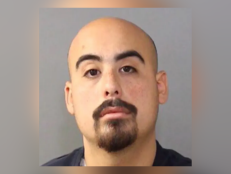Which State Has The Most Serial Killers And Why?

Wikimedia Commons
The Sterling Highway in Alaska
Alaska is a state known for untouched nature and killer views — and another statistic that we doubt the tourism board will be promoting: The region’s very high rate of serial killers.
24/7 Wall St. scoured the Serial Killer Database, which is produced through a partnership between Radford University and the Florida Gulf Coast University, to determine the state with the highest rate of serial killers.
Adjusted for population, Alaska came out on top: The state had 51 serial murder cases as of 2014. And this did not include the huge spike in homicides in 2016 that had residents of the city Anchorage on edge after nine people were murdered on trails, in parks, and on isolated streets.

Anchorage Police Department handout
Police artist sketch compared to James Dale Ritchie’s driver’s license photo
In November 2016, James Dale Ritchie was linked to five of the homicides — including two double murders. Ritchie, 40, came to Alaska from Virginia, where those who knew him described him as “super intelligent.” He was a talented athlete in high school, but his life reportedly began to unravel in 1998 after he was arrested in a drug investigation.
He wrote a letter to the judge, claiming he “lay in bed every night thinking about how I’ve ruined my life. Then I sit up crying wishing I could go back to when I was in high school.” Other arrests followed, for DWI in 1999 and burglary in 2005, court records show — and then he made the move to Alaska. After shooting an Anchorage police officer, Ritchie was killed by cops.
On April 26, 2017, Anchorage police announced that they concluded that Ritchie was officially responsible for the deaths of the five people. Those five murders counted among what was a record number of killings in Anchorage alone in 2016 — 34.
So why does Alaska have so many serial killers?
Some experts believe that the privacy that Alaska offers is one of the most appealing advantages of the state for many — unfortunately, this same solitude also can attract people who are running from something.
Experts have speculated that the long hours of darkness for many days out of the year could also be a factor, as well as the vast areas of wilderness that can be used to dispose of bodies.
Also, according to The Washington Post, there are at least 75 Native-American Alaskan villages that don’t have any law enforcement, so when a crime happens they have to wait — sometimes hours — for Alaska State Troopers to arrive.
Another element that’s specific to Alaska’s population is the huge number of seasonal workers, due to the need for staff in oil-pipeline construction and logging — which also attracts a large number of sex workers to service the largely male population.
Robert Hansen, perhaps the most prolific serial killer in the state’s history, was sentenced to 461 years of prison in 1984 after confessing to the particularly gruesome murders 17 women.
Many of Hansen’s victims were dancers and sex workers, and Trooper Glenn Flothe told the Anchorage Daily News in 2008 that Hansen believed that these victims were less likely to be missed.
Indeed, since seasonal and temporary workers were commonplace during this era due to the construction of the trans-Alaska oil pipeline, Hansen was able to continue his crime spree unchecked for over a decade. Even the victims who escaped Hansen were threatened with arrest while he continued killing for years.
Sadly, the disappearance of minority women may be even more likely to be overlooked by law enforcement. The victims of serial killer Joshua Wade, who killed five women between 2002 and 2007, were Native Alaskan and African-American.
Their murders may never have been linked if not for the work of investigative journalist Monte Francis, author of Ice and Bone: Tracking an Alaskan Serial Killer.
Not only does Alaska have a higher incidence of serial killings than any other state, but it also has one of the highest violent crime rates in general in the country at 730.2 violent crimes per 100,000 compared to a national average of 372.6, according to the FBI 2015 crime report.
Read more: The Guardian, The Huffington Post , 24tWallSt, The Washington Post, KTUU.com









